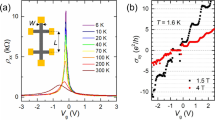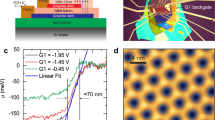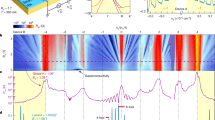Abstract
Graphene has demonstrated great promise for future electronics technology as well as fundamental physics applications because of its linear energy–momentum dispersion relations which cross at the Dirac point1,2. However, accessing the physics of the low-density region at the Dirac point has been difficult because of disorder that leaves the graphene with local microscopic electron and hole puddles3,4,5. Efforts have been made to reduce the disorder by suspending graphene, leading to fabrication challenges and delicate devices which make local spectroscopic measurements difficult6,7. Recently, it has been shown that placing graphene on hexagonal boron nitride (hBN) yields improved device performance8. Here we use scanning tunnelling microscopy to show that graphene conforms to hBN, as evidenced by the presence of Moiré patterns. However, contrary to predictions9,10, this conformation does not lead to a sizeable band gap because of the misalignment of the lattices. Moreover, local spectroscopy measurements demonstrate that the electron–hole charge fluctuations are reduced by two orders of magnitude as compared with those on silicon oxide. This leads to charge fluctuations that are as small as in suspended graphene6, opening up Dirac point physics to more diverse experiments.
This is a preview of subscription content, access via your institution
Access options
Subscribe to this journal
Receive 12 print issues and online access
$259.00 per year
only $21.58 per issue
Buy this article
- Purchase on Springer Link
- Instant access to full article PDF
Prices may be subject to local taxes which are calculated during checkout




Similar content being viewed by others
References
Geim, A. K. & Novoselov, K. S. The rise of graphene. Nature Mater. 6, 183–191 (2007).
Castro Neto, A. H., Guinea, F., Peres, N. M. R., Novoselov, K. S. & Geim, A. K. The electronic properties of graphene. Rev. Mod. Phys. 81, 109–162 (2009).
Martin, J. et al. Observation of electron–hole puddles in graphene using a scanning single-electron transistor. Nature Phys. 4, 144–148 (2008).
Deshpande, A., Bao, W., Miao, F., Lau, C. N. & LeRoy, B. J. Spatially resolved spectroscopy of monolayer graphene on SiO2 . Phys. Rev. B 79, 205411 (2009).
Zhang, Y., Brar, V. W., Girit, C., Zettl, A. & Crommie, M. F. Origin of spatial charge inhomogeneity in graphene. Nature Phys. 5, 722–726 (2009).
Du, X., Skachko, I., Barker, A. & Andrei, E. Y. Approaching ballistic transport in suspended graphene. Nature Nanotech. 3, 491–495 (2008).
Bolotin, K. I., Sikes, K. J., Hone, J., Stormer, H. L. & Kim, P. Temperature-dependent transport in suspended graphene. Phys. Rev. Lett. 101, 096802 (2008).
Dean, C. R. et al. Boron nitride substrates for high-quality graphene electronics. Nature Nanotech. 5, 722–726 (2010).
Giovannetti, G., Khomyakov, P. A., Brocks, G., Kelly, P. J. & van den Brink, J. Substrate-induced band gap in graphene on hexagonal boron nitride: Ab initio density functional calculations. Phys. Rev. B 76, 073103 (2007).
Slawinska, J., Zasado, I. & Klusek, Z. Energy gap tuning in graphene on hexagonal boron nitride bilayer system. Phys. Rev. B 81, 155433 (2010).
Novoselov, K. S. et al. Two-dimensional atomic crystals. Proc. Natl Acad. Sci. USA 102, 10451–10453 (2005).
Chen, J-H. et al. Charged-impurity scattering in graphene. Nature Phys. 4, 377–381 (2008).
Rossi, E. & Das Sarma, S. Ground state of graphene in the presence of random charged impurities. Phys. Rev. Lett. 101, 166803 (2008).
Du, X., Skachko, I., Duerr, F., Luican, A. & Andrei, E. Y. Fractional quantum Hall effect and insulating phase of Dirac electrons in graphene. Nature 462, 192–195 (2009).
Bolotin, K. I., Ghahari, F., Shulman, M. D., Stormer, H. L. & Kim, P. Observation of the fractional quantum Hall effect in graphene. Nature 462, 196–199 (2009).
Bao, W. et al. Controlled ripple texturing of suspended graphene and ultrathin graphite membranes. Nature Nanotech. 4, 562–566 (2009).
Liu, L., Feng, Y. P. & Shen, Z. X. Structural and electronic properties of h-BN. Phys. Rev. B 68, 104102 (2003).
Watanabe, K., Taniguchi, T. & Kanda, H. Direct-bandgap properties and evidence for ultraviolet lasing of hexagonal boron nitride single crystal. Nature Mater. 3, 404–409 (2004).
Cullen, W. G. et al. High-fidelity conformation of graphene to SiO2 topographic features. Phys. Rev. Lett. 100, 215504 (2010).
Ishigami, M., Chen, J. H., Cullen, W. G., Fuhrer, M. S. & Williams, E. D. Atomic structure of graphene on SiO2 . Nano Lett. 7, 1643–1648 (2007).
Stolyarova, E. et al. High-resolution scanning tunnelling microscopy imaging of mesoscopic graphene sheets on an insulating surface. Proc. Natl Acad. Sci. USA 104, 9209–9212 (2007).
Lui, C. H., Liu, L., Mak, K. F., Flynn, G. W. & Heinz, T. F. Ultraflat graphene. Nature 462, 339–341 (2009).
Kim, E. A. & Castro Neto, A. H. Graphene as an electronic membrane. Europhys. Lett. 84, 57007 (2009).
Guinea, F., Katsnelson, M. I. & Vozmediano, M. A. H. Midgap states and charge inhomogeneities in corrugated graphene. Phys. Rev. B 77, 0705422 (2008).
Choudhury, S. K. & Gupta, A. K. Tip induced doping effects in local tunnel spectra of graphene. Preprint at http://arxiv.org/abs/1008.3606v1 (2010).
Zhang, L. M. et al. Determination of the electronic structure of bilayer graphene from infrared spectroscopy. Phys. Rev. B 78, 235408 (2008).
Li, G., Luican, A. & Andrei, E. Y. Scanning tunnelling spectroscopy of graphene on graphite. Phys. Rev. Lett. 102, 176804 (2009).
Taniguchi, T. & Watanabe, K. Synthesis of high-purity boron nitride single crystals under high pressure by using Ba–Bn solvent. J. Cryst. Growth 303, 525–529 (2007).
Meyer, J. C. et al. The structure of suspended graphene sheets. Nature 446, 60–63 (2007).
Young, A. F. et al. Electronic compressibility of gapped bilayer graphene. Preprint at http://arxiv.org/abs/1004.5556v2 (2010).
Acknowledgements
The authors would like to thank W. Bao, Z. Zhao and C. N. Lau for providing the graphene on SiO2 samples used for the comparison with graphene on hBN. J.X., A.D. and B.J.L. were supported by US Army Research Laboratory and the US Army Research Office under contract/grant number W911NF-09-1-0333 and the National Science Foundation CAREER award DMR-0953784. P.J. was supported by the National Science Foundation under award DMR-0706319. J.S-Y., D.B. and P.J-H. were supported by the US Department of Energy, Office of Basic Energy Sciences, Division of Materials Sciences and Engineering under Award DE-SC0001819 and by the 2009 US Office of Naval Research Multi University Research Initiative (MURI) on Graphene Advanced Terahertz Engineering (Gate) at MIT, Harvard and Boston Unversity.
Author information
Authors and Affiliations
Contributions
J.X. and B.J.L. performed the STM experiments for graphene on hBN. A.D. performed the STM experiments for graphene on SiO2. J.S-Y. and D.B. fabricated the devices. P.J. performed the theoretical calculations. K.W. and T.T. provided the single crystal hBN. P.J-H. and B.J.L. conceived and provided advice on the experiments. All authors participated in discussing the data and writing the manuscript.
Corresponding author
Ethics declarations
Competing interests
The authors declare no competing financial interests.
Supplementary information
Supplementary Information
Supplementary Information (PDF 745 kb)
Rights and permissions
About this article
Cite this article
Xue, J., Sanchez-Yamagishi, J., Bulmash, D. et al. Scanning tunnelling microscopy and spectroscopy of ultra-flat graphene on hexagonal boron nitride. Nature Mater 10, 282–285 (2011). https://doi.org/10.1038/nmat2968
Received:
Accepted:
Published:
Issue Date:
DOI: https://doi.org/10.1038/nmat2968
This article is cited by
-
Electrostatic moiré potential from twisted hexagonal boron nitride layers
Nature Materials (2024)
-
Room-temperature ferroelectricity in van der Waals SnP2S6
Frontiers of Physics (2024)
-
Controlled alignment of supermoiré lattice in double-aligned graphene heterostructures
Nature Communications (2023)
-
Unidirectional alignment and orientation pinning mechanism of h-BN nucleation on Ir(111) via reactive probe atomic force microscopy
Communications Materials (2023)
-
Electrical control of transient formation of electron-hole coexisting system at silicon metal-oxide-semiconductor interfaces
Communications Physics (2023)



